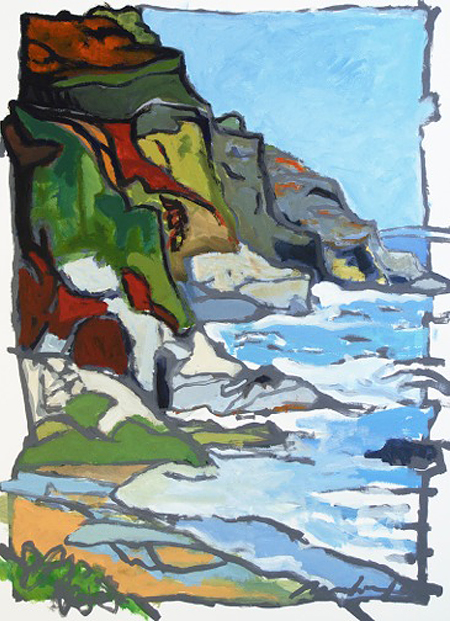
Continuing through December 2, 2013
What is the relationship between drawing and painting? In the case of Richard Morhous, it is a bond so close as to be a stranglehold. As a tipoff, Morhous has included a “facsimile sketchbook” of all the drawings that were used to inspire the 30 acrylic on paper works. Viewers can note the shifts, transitions, corrections and amplifications between the original impulses and the completed paintings.
With his background in graphic design and printmaking at the University of Washington and the Prahan Institute of Technology in Melbourne, Australia, the 68-year-old South Dakota native turned away rather early on from printmaking due to studio allergies and has painted in acrylic for the past 30 years. Even so, the strong, defining outlines of prints are still present and the truncated, cropped-off imagery of graphic design and illustration nag each painting. Imagery is therefore compressed, but rarely breathes freely.
Largely a regional phenomenon, having exhibited only in Idaho and Oregon besides Seattle, Morhous’s representational scenes of streets, interiors, cityscapes and landscapes are at their most varied in this grouping and point in several directions that could free up the pictures and push them closer to the latent abstraction they quietly seek.
When the outlines are effective, they emphasize the sketchy spontaneity of a drawing, but fail to push the work into a categorical painting; when they are overbearing, they lock in the view, trapping it in a morass of criss-crosses, heavy linear weights, and downward drags. The best of the new work eludes or balances such potential pitfalls and allows the paintings to retain all their structure while carrying the imagery more gracefully. “Wings” and “Silhouettes” are a good example, with the former’s red curtains heavily anchored by thick black lines. The latter is enclosed by two vertical black posts that also act as curtains on either side of a window revealing a tall building. “Wings” is too schematic; “Silhouette” is proportional and balanced.
Given such extremely traditional and conservative subjects — still life, seascape, architecture — there is plenty of variety, albeit predictable and unsurprising. The smaller works are the sketchiest, i.e., closest to drawings, yet “Apostles” and “Nosh,” an ocean scene and a table top of food, averaging seven by ten inches, strive to be paintings amid the overkill of outlines. A few welcome jabs of white paint in the coastal view liberate its stolid sinking of half-submerged rocks and boulders. “Lush,” “Geometry,” “Back Road,” and “Late Night Mambo” are like the old Morhous: echoes or yearnings of 1930s French painting á la Vlaminck or Derain. Linear clots of black hem in bright primary colors, but do not permit clear optical access into the painting.
Among the urbanscapes, “Ziggurat,” “Pesto,” “Haven,” “Noir” and “Lombard Cha Cha” alternately close off and invite the viewer to go past the surface into each picture’s shallow picture plane. “Cascade” is a set of New York City brownstone staircases seen from the side; they are anatomized further in “Pesto.” “Haven” appears to be a bench in Central Park at night, but the tangle of black detailing crushes the entry path at its lower left corner.
As is common wit this veteran artist, strengths and weaknesses exist side by side as paintings strive to escape drawing status with varying degrees of success. Fortunately, several works point toward what could become a greater modernist maturity. Thus far, Morhous’ big breakthrough is transitioning from thick black outlines to soft gray ones. The results are immediately evident in several new pictures’ openness and breathability. “Still,” the smallest and most abstract, shares a scene of meandering water with “Haze” and “Dragon Fly,” two larger paintings. Flattest of all, “Still” sections off cliffs and streams with soft gray lines and spots of red and blue. Like opening a door on a balcony, “Haze” offers a water view with waves crashing on a beach. Ragged horizontal lines at its right edge point beyond to a kind of illustrational shorthand, countered by paler and paler shades of blue — land, water, sky — that are exhilarating.
Finally, “Dragon Fly” is just sketchy enough without overdoing it. A churning stream with a rocky meadow beyond, its rich blues, reds, yellows, and greens blend into an artist’s view of nature, all the while filtered through Morhous’ increasing control over juxtaposing solid areas of color. When the otherwise constricting outlines are underplayed, as in these works, the artist’s previously unacknowledged power to use pure color as structure is at last revealed.
